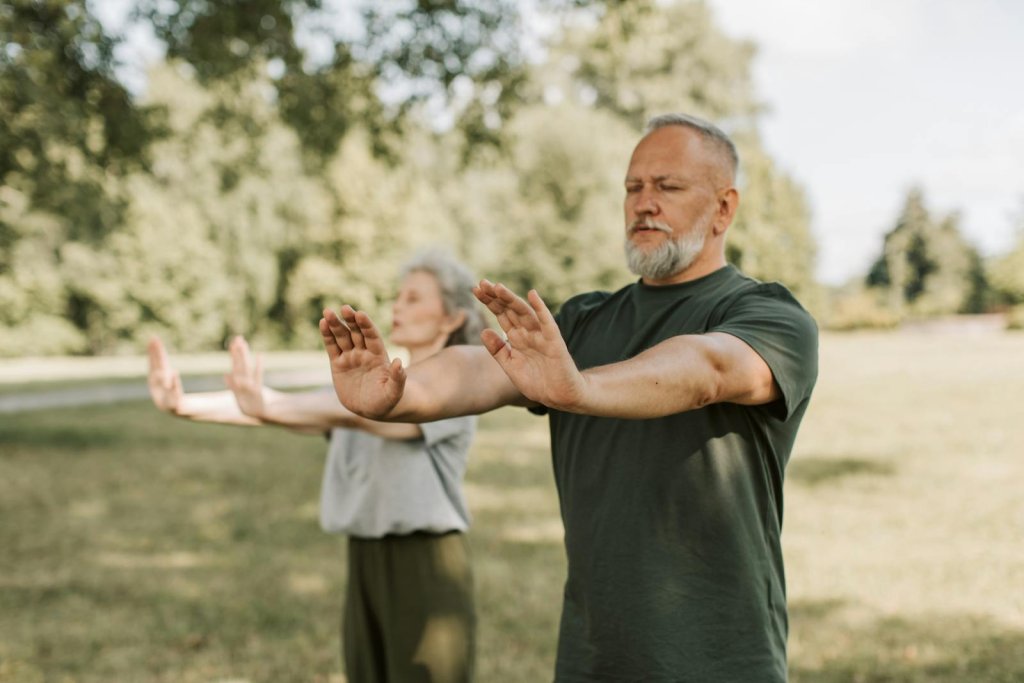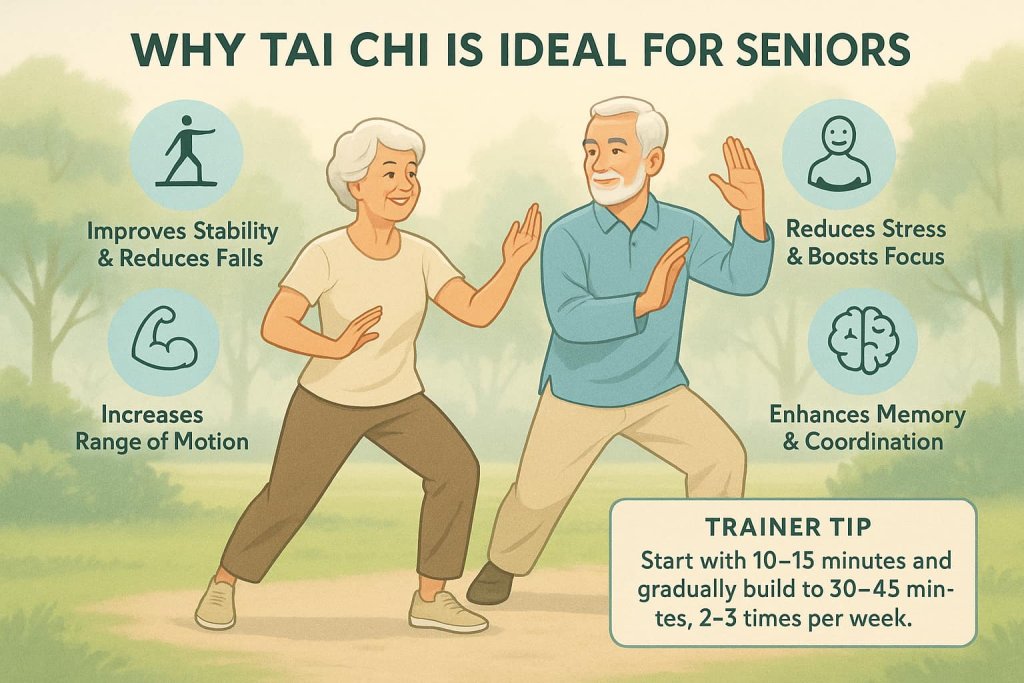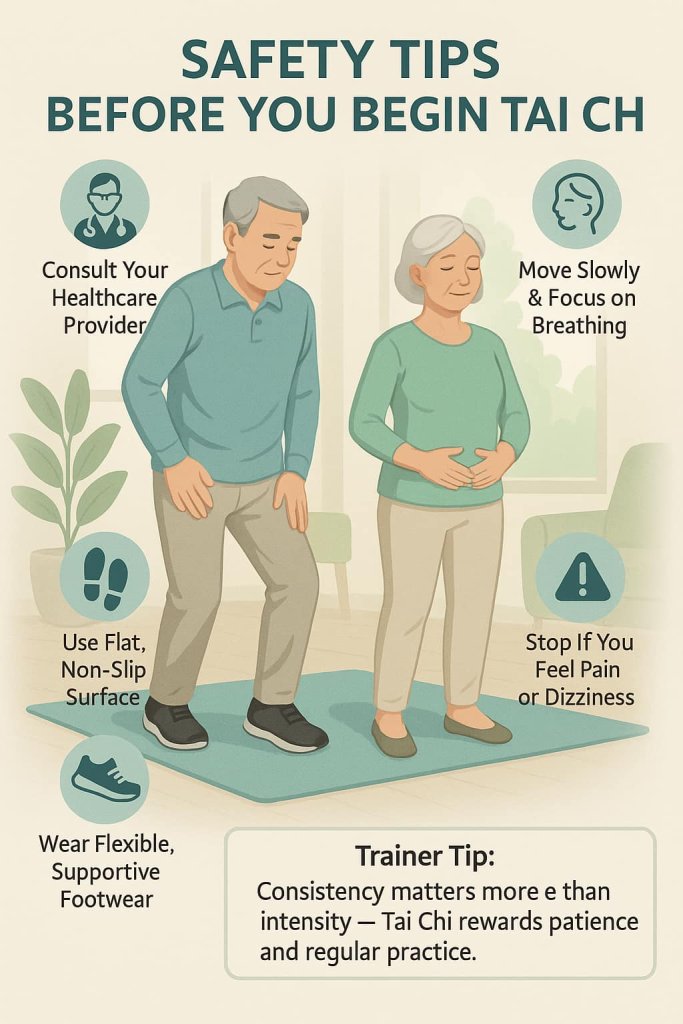Tai Chi is one of the safest and most effective forms of exercise for seniors to improve balance, flexibility, and peace of mind.
This gentle, low-impact martial art blends slow, flowing movements with deep breathing and focus — helping older adults build strength, coordination, and calmness without strain or equipment.

Tai Chi is especially valuable for seniors because it reduces fall risk, enhances joint mobility, and supports cognitive health, according to Harvard Health and the National Institutes of Health. Studies show regular practice can boost balance confidence, reduce stress, and even improve sleep quality.
In this guide, you’ll discover the 8 best Tai Chi exercises for seniors, along with benefits, beginner tips, and safety advice — all based on the latest evidence and expert guidelines.
What Is Tai Chi and Why It’s Ideal for Seniors
Tai Chi, also called Tai Chi Chuan, originated in ancient China as a martial art emphasizing controlled movement and inner balance. Today, it’s widely practiced as a wellness discipline combining mind-body coordination, breathing, and posture.

Why Tai Chi Works for Older Adults
According to research published in BMC Geriatrics , Tai Chi improves both physical balance and cognitive function, helping seniors stay active and mentally sharp.
A meta-analysis reported that short-term Tai Chi programs (≤12 weeks) performed more than twice per week for ≥45 minutes per session significantly improve balance in older adults, and broader evidence shows Tai Chi reduces fall risk in this population.
Key Benefits
- Improves balance and reduces fall risk by enhancing proprioception
- Increases flexibility and joint range of motion
- Strengthens legs, core, and posture muscles
- Reduces anxiety, stress, and depression symptoms
- Enhances focus, memory, and coordination
Trainer Tip: Start with short sessions (10–15 minutes) and progress gradually to 30–45 minutes, two or three times per week.
Safety Tips Before You Begin

Before starting Tai Chi:
- Consult your healthcare provider if you have chronic pain, dizziness, or balance disorders.
- Practice on a flat, non-slippery surface.
- Wear supportive, flexible shoes or go barefoot indoors.
- Move slowly and focus on breathing — avoid sudden turns or deep bends.
- Stop if you feel pain, shortness of breath, or instability.
Trainer Tip: Consistency matters more than intensity — Tai Chi rewards patience and regular practice.
8 Best Tai Chi Exercises for Seniors
Below are 8 beginner-friendly Tai Chi movements designed to improve mobility, balance, and relaxation.
1. Commencement (Qi Shi)
Why it works:
This gentle opening move centers the body, improves posture, and promotes deep, mindful breathing. It helps seniors prepare mentally and physically for the flow of Tai Chi, awakening core engagement and coordination.
Muscles worked:
Core stabilizers, shoulders, upper back, and diaphragm.
How to do it:
- Stand tall with feet shoulder-width apart and knees slightly bent.
- Keep spine neutral and shoulders relaxed.
- Inhale deeply through your nose as you raise both arms slowly to shoulder height, palms facing down.
- Exhale through the mouth as you lower your arms gently to your sides.
- Repeat 5–10 times, maintaining smooth, steady breathing.
Trainer Tip:
Focus on your breathing rhythm — it sets the pace for your entire Tai Chi session. Move slowly and with full awareness.
2. Parting the Wild Horse’s Mane
Why it works:
Builds leg stability, coordination, and smooth hand–foot synchronization. This move improves mobility in the hips and knees while cultivating graceful control.
Muscles worked:
Quadriceps, glutes, hamstrings, shoulders, and arms.
How to do it:
- Step your left foot forward into a gentle lunge.
- As you shift weight forward, move your right hand up and left hand down as if “parting a horse’s mane.”
- Keep back straight and gaze forward.
- Return to the starting position and repeat on the other side.
- Perform 6–8 repetitions on each side.
Trainer Tip:
Move as if your hands are floating through water — smooth, controlled, and effortless.
3. White Crane Spreads Its Wings
Why it works:
Improves posture, spine alignment, and shoulder mobility. Encourages balance and calm breathing coordination.
Muscles worked:
Upper back, shoulders, triceps, and core.
How to do it:
- Start with feet together, knees slightly bent.
- Slowly raise one arm upward and the other downward in a gentle, flowing arc.
- Keep your torso tall and eyes relaxed.
- Alternate sides, breathing deeply and maintaining even rhythm.
Trainer Tip:
Visualize your arms moving gracefully like a bird spreading its wings — light, controlled, and elegant.
4. Brush Knee and Push
Why it works:
Trains coordination between the upper and lower body while improving balance, rhythm, and cross-body movement.
Muscles worked:
Glutes, hamstrings, calves, deltoids, and obliques.
How to do it:
- Step forward with your left foot while brushing your left hand past your knee.
- Simultaneously push forward with your right hand, palm facing outward.
- Return to standing and switch sides.
- Perform 8–10 repetitions per side.
Trainer Tip:
Engage your core and keep movements continuous — avoid jerky transitions.
5. Wave Hands Like Clouds
Why it works:
Improves hip mobility, balance, and coordination through smooth lateral shifts. Ideal for joint health and stability.
Muscles worked:
Glutes, thighs, core, and shoulders.
How to do it:
- Stand with knees slightly bent.
- Shift weight from one leg to the other as you wave your hands horizontally across your body.
- Keep movements soft and fluid like gentle waves.
- Continue for 1–2 minutes, breathing evenly.
Trainer Tip:
Focus on keeping your head level as you move — this strengthens control and balance.
6. Golden Rooster Stands on One Leg
Why it works:
Enhances single-leg balance, ankle stability, and proprioception — key for fall prevention.
Muscles worked:
Ankles, calves, glutes, quadriceps, and core stabilizers.
How to do it:
- Stand tall, slowly lift one leg to knee height.
- Raise the opposite arm as if balancing on a tightrope.
- Hold for 3–5 seconds, then switch sides.
- Perform 4–6 repetitions per leg.
Trainer Tip:
Focus your eyes on a fixed point ahead to maintain balance. Start near a chair or wall if needed for support.
7. Repulse Monkey
Why it works:
Trains backward walking control, balance, and spatial awareness — often neglected but crucial for fall prevention.
Muscles worked:
Hamstrings, calves, glutes, and upper back.
How to do it:
- Step one foot back slowly while pushing both hands forward as if gently repelling an object.
- Return to standing and switch legs.
- Continue alternating for 8–10 repetitions.
Trainer Tip:
Keep your steps small and deliberate — focus on smooth, even breathing as you move backward.
8. Fair Lady Works the Shuttles
Why it works:
Boosts coordination and focus through multi-directional movement. It also enhances hip rotation and spinal flexibility.
Muscles worked:
Hips, shoulders, arms, and obliques.
How to do it:
- Stand with feet wide, knees slightly bent.
- Rotate your torso diagonally while extending your arms gracefully as if weaving fabric across corners.
- Keep movements slow and rhythmic.
- Perform 6–8 repetitions on each side.
Trainer Tip:
Imagine painting gentle arcs in the air with your hands — move smoothly and stay relaxed through your torso.
How to Make Tai Chi a Daily Habit
Consistency is key — even 10–20 minutes a day can improve balance, mobility, and calmness.
- Start small: Begin with 2–3 basic moves.
- Set a schedule: Practice at the same time daily.
- Create space: Use a quiet, safe area.
- Follow guidance: Join a class or online video.
- Track progress: Note balance, focus, and energy changes.
Trainer Tip: Combine Tai Chi with deep breathing or meditation for greater relaxation.
Common Mistakes Beginners Should Avoid
Avoiding simple errors keeps your Tai Chi safe and effective.
- Moving too fast — focus on control and flow.
- Holding breath — breathe naturally with movement.
- Locking joints — keep knees slightly bent.
- Poor posture — stand tall, relax shoulders.
- Skipping warm-up — loosen joints before starting.
- Slippery surface — always practice on stable ground.
Trainer Tip: Use a mirror or record yourself to check posture and form.
Health Benefits Backed by Research
- Fall prevention: Tai Chi reduces falls by up to 50% in seniors (NIH).
- Cardiovascular health: Lowers blood pressure and resting heart rate (Harvard Health).
- Mental well-being: Evidence shows that Tai Chi reduces perceived stress and improves mood in older adults, with mind-body organizations also recommending Tai Chi as a relaxation practice.
- Joint and muscle support: Enhances range of motion in knees and hips, supporting arthritis management (Arthritis Foundation).
FAQ
1. Is Tai Chi safe for seniors with arthritis or joint pain?
Yes. Tai Chi is low-impact and can ease stiffness when practiced gently, as supported by the Arthritis Foundation .
2. How long does it take to see benefits from Tai Chi?
Most people notice improvements in balance and relaxation within 6–8 weeks of consistent practice.
3. Can I do Tai Chi if I use a chair or walker?
Absolutely. Chair-based or supported Tai Chi variations are designed for limited mobility and are equally beneficial.
4. What time of day is best for Tai Chi?
Morning sessions help energize you for the day, while evening sessions calm the body and improve sleep.
5. Do I need equipment for Tai Chi?
No — just comfortable clothing, a quiet space, and optional music for rhythm and focus.
6. Can Tai Chi improve mental health?
Yes. Research shows Tai Chi reduces anxiety and enhances mindfulness in older adults.
7. Should seniors combine Tai Chi with other exercises?
Yes. Pairing Tai Chi with walking, stretching, or light strength training offers optimal health benefits.
Conclusion
Tai Chi is more than just movement — it’s a path to lifelong balance, flexibility, and calm.
For seniors, it’s one of the safest and most rewarding ways to stay active both mentally and physically. Start slowly, focus on your breathing, and enjoy every mindful step of your journey toward better health and peace.
Takeaway: Just 15–30 minutes of Tai Chi, 2–3 times per week, can dramatically improve your strength, stability, and serenity — no matter your age.
